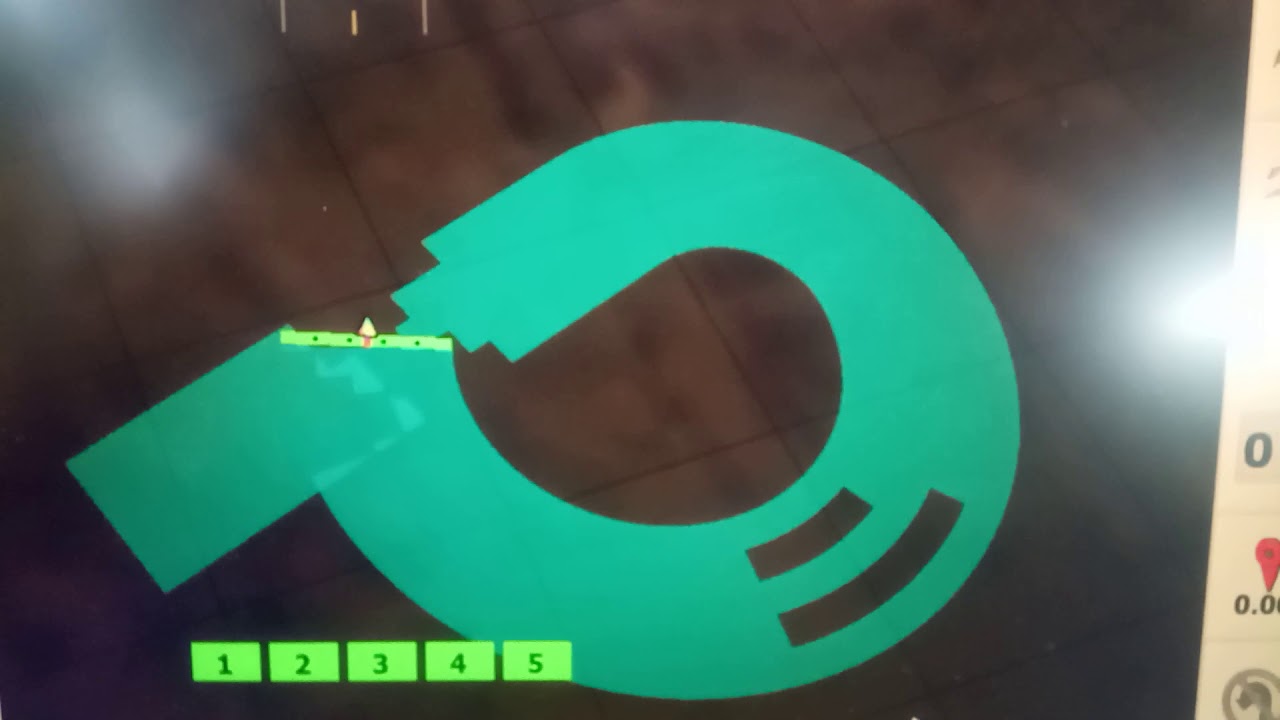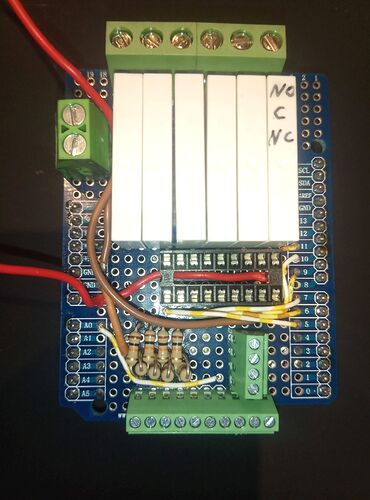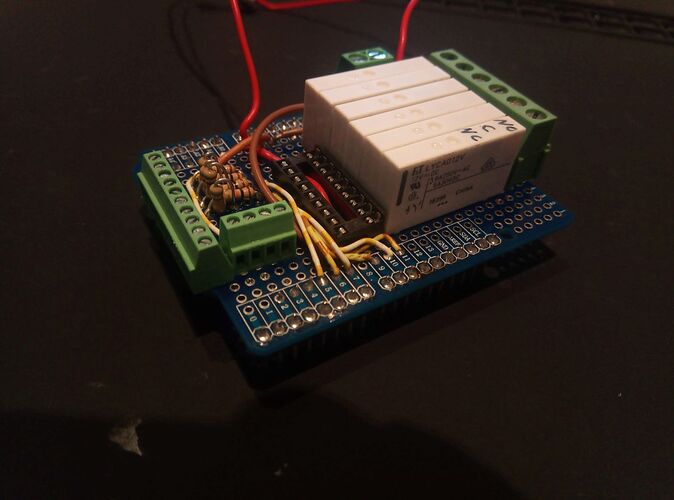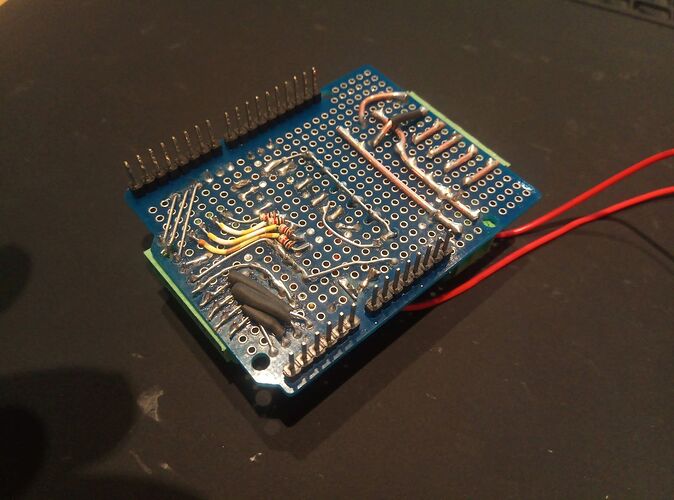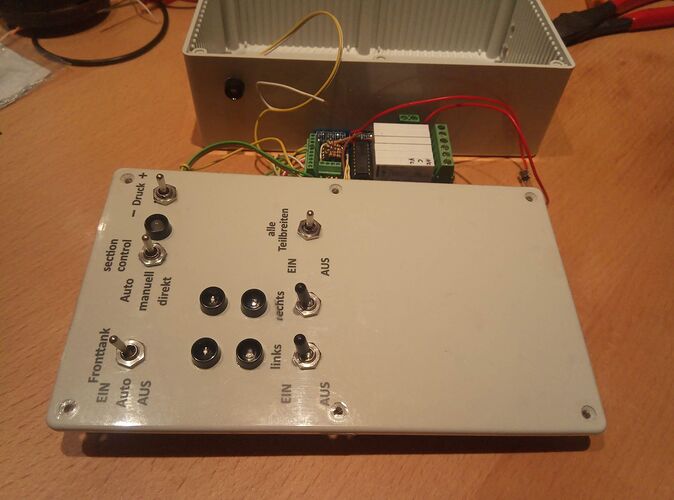Hi,
I have modified the code for AgOpenGPS 4.2.0.x
is also for ESP32 DevKit to connect the sections relays over bluetooth.
/*
* This program only turns the relays for section control
* On and Off. Connect to the Relay Port in AgOpenGPS
*/
//loop time variables in microseconds
#include "BluetoothSerial.h"
#include <EEPROM.h>
#define EEP_Ident 0x4201
BluetoothSerial ESP_BT;
//Program counter reset
void(* resetFunc) (void) = 0;
//pins on ESP32 devKit
const int seccio1 = 27;
const int seccio2 = 26;
const int seccio3 = 25;
const int seccio4 = 33;
const int seccio5 = 32;
//this is a relay to enable a valve to despresurize all the sections, is enabled when all sections are off
const int general = 21;
//Variables for config - 0 is false
struct Config {
byte raiseTime = 2;
byte lowerTime = 4;
byte enableToolLift = 0;
byte isRelayActiveHigh = 0; //if zero, active low (default)
}; Config aogConfig; //4 bytes
const byte LOOP_TIME = 200; //5hz
unsigned long lastTime = LOOP_TIME;
unsigned long currentTime = LOOP_TIME;
unsigned long fifthTime = 0;
unsigned int count = 0;
//Comm checks
byte watchdogTimer = 0; //make sure we are talking to AOG
byte serialResetTimer = 0; //if serial buffer is getting full, empty it
//Communication with AgOpenGPS
bool isDataFound = false, isSettingFound = false, isAogConfigFound = false, isRelayActiveHigh = true;
int header = 0, tempHeader = 0, temp, EEread = 0;
//The variables used for storage
byte relayHi=0, relayLo = 0, gpsSpeed = 0, tramline = 0, tree = 0, uTurn = 0, hydLift = 0;
byte raiseTimer = 0, lowerTimer = 0, lastTrigger = 0;
//Raise and lower as D4 and D3
#define RAISE 4
#define LOWER 3
void setup()
{
Serial.begin(38400);
ESP_BT.begin("AGOpenGPS_reles"); //Name of your Bluetooth Signal
Serial.println("Bluetooth Device is Ready to Pair");
//set the baud rate
//Serial.begin(38400);
while (!ESP_BT.available()) { ; } // wait for serial port to connect. Needed for native USB
EEPROM.get(0, EEread); // read identifier
if (EEread != EEP_Ident) // check on first start and write EEPROM
{
EEPROM.put(0, EEP_Ident);
EEPROM.put(6, aogConfig);
}
else
{
EEPROM.get(6, aogConfig);
}
//set the pins to be outputs (pin numbers)
pinMode(LOWER, OUTPUT);
pinMode(RAISE, OUTPUT);
pinMode(seccio1, OUTPUT);
pinMode(seccio2, OUTPUT);
pinMode(seccio3, OUTPUT);
pinMode(seccio4, OUTPUT);
pinMode(seccio5, OUTPUT);
pinMode(general, OUTPUT);
//set all relays sections to OFF exept despresurize valve
digitalWrite(seccio1, LOW);
digitalWrite(seccio2, LOW);
digitalWrite(seccio3, LOW);
digitalWrite(seccio4, LOW);
digitalWrite(seccio5, LOW);
digitalWrite(general, HIGH);
}
void loop()
{
//Loop triggers every 200 msec and sends back gyro heading, and roll, steer angle etc
currentTime = millis();
unsigned int time = currentTime;
if (currentTime - lastTime >= LOOP_TIME)
{
lastTime = currentTime;
//If connection lost to AgOpenGPS, the watchdog will count up
if (watchdogTimer++ > 250) watchdogTimer = 12;
//clean out serial buffer to prevent buffer overflow
if (serialResetTimer++ > 20)
{
while (ESP_BT.available() > 0) char t = ESP_BT.read();
serialResetTimer = 0;
}
if (watchdogTimer > 10)
{
relayLo = 0;
relayHi = 0;
}
//hydraulic lift
if (hydLift != lastTrigger && (hydLift == 1 || hydLift == 2))
{
lastTrigger = hydLift;
lowerTimer = 0;
raiseTimer = 0;
//200 msec per frame so 5 per second
switch (hydLift)
{
//lower
case 1:
lowerTimer = aogConfig.lowerTime * 5;
break;
//raise
case 2:
raiseTimer = aogConfig.raiseTime * 5;
break;
}
}
//countdown if not zero, make sure up only
if (raiseTimer)
{
raiseTimer--;
lowerTimer = 0;
}
if (lowerTimer) lowerTimer--;
//if anything wrong, shut off hydraulics, reset last
if ((hydLift != 1 && hydLift != 2) || watchdogTimer > 10 ) //|| gpsSpeed < 2)
{
lowerTimer = 0;
raiseTimer = 0;
lastTrigger = 0;
}
//section relays
SetRelays();
//Send data back to agopenGPS
ESP_BT.print(127); //steering switch status
ESP_BT.print(",");
ESP_BT.print(248); //steering switch status
ESP_BT.print(",");
ESP_BT.print(raiseTimer); //steering switch status
ESP_BT.print(",");
ESP_BT.print(lowerTimer); //steering switch status
ESP_BT.print(",");
ESP_BT.print(hydLift); //steering switch status
ESP_BT.print(",");
ESP_BT.print(aogConfig.isRelayActiveHigh); //steering switch status
ESP_BT.print(",0,0,0,");
ESP_BT.println(0);
/*
Serial.print(",");
Serial.print(gpsSpeed); //steering switch status
Serial.print(",");
Serial.print(hydLift); //steering switch status
Serial.print(",");
Serial.print(lastTrigger); //steering switch status
Serial.print(",");
Serial.println(aogConfig.lowerTime); //steering switch status
*/
ESP_BT.flush(); // flush out buffer
} //end of timed loop
//****************************************************************************************
//This runs continuously, outside of the timed loop, keeps checking UART for new data
// PGN - 32762 - 127.250 0x7FFA
//public int mdHeaderHi, mdHeaderLo = 1, mdSectionControlByteHi = 2, mdSectionControlByteLo = 3,
//mdSpeedXFour = 4, mdUTurn = 5, mdTree = 6, mdHydLift = 7, md8 = 8, md9 = 9;
if (ESP_BT.available() > 0 && !isDataFound && !isAogConfigFound) //find the header, 127H + 254L = 32766
{
int temp = ESP_BT.read();
header = tempHeader << 8 | temp; //high,low bytes to make int
tempHeader = temp; //save for next time
if (header == 32762) isDataFound = true; //Do we have a match?
if (header == 32760) isAogConfigFound = true; //Do we have a match?
}
//Data Header has been found, so the next 6 bytes are the data
if (ESP_BT.available() > 7 && isDataFound)
{
isDataFound = false;
relayHi = ESP_BT.read();
relayLo = ESP_BT.read(); // read relay control from AgOpenGPS
gpsSpeed = ESP_BT.read() >> 2; //actual speed times 4, single byte
uTurn = ESP_BT.read();
tree = ESP_BT.read();
hydLift = ESP_BT.read();
//just get the rest of bytes
ESP_BT.read(); //high,low bytes
ESP_BT.read();
//reset watchdog
watchdogTimer = 0;
//Reset serial Watchdog
serialResetTimer = 0;
}
//Arduino Config Header has been found, so the next 8 bytes are the data
if (ESP_BT.available() > 7 && isAogConfigFound)
{
isAogConfigFound = false;
aogConfig.raiseTime = ESP_BT.read();
aogConfig.lowerTime = ESP_BT.read();
aogConfig.enableToolLift = ESP_BT.read();
//set1
byte sett = ESP_BT.read(); //setting0
if (bitRead(sett,0)) aogConfig.isRelayActiveHigh = 1; else aogConfig.isRelayActiveHigh = 0;
ESP_BT.read();
ESP_BT.read();
ESP_BT.read();
ESP_BT.read();
//save in EEPROM and restart
EEPROM.put(6, aogConfig);
resetFunc();
}
}
void SetRelays(void)
{
if (aogConfig.isRelayActiveHigh)
{
//active low
/* if (lowerTimer) bitClear(PORTD, LOWER); //Digital Pin D3
else bitSet(PORTD, LOWER);
if (raiseTimer) bitClear(PORTD, RAISE); //Digital Pin D4
else bitSet(PORTD, RAISE);
*/
Serial.println(relayLo);
if (bitRead(relayLo,0)) digitalWrite(seccio1, LOW); //Digital Pin 5
else digitalWrite(seccio1, HIGH);
if (bitRead(relayLo,1)) digitalWrite(seccio2, LOW); //Digital Pin 6
else digitalWrite(seccio2, HIGH);
if (bitRead(relayLo,2)) digitalWrite(seccio3, LOW); //Digital Pin 7
else digitalWrite(seccio3, HIGH);
if (bitRead(relayLo,3)) digitalWrite(seccio4, LOW); //Digital Pin 8
else digitalWrite(seccio4, HIGH);
if (bitRead(relayLo,4)) digitalWrite(seccio5, LOW); //Digital Pin 9
else digitalWrite(seccio5, HIGH);
/*if (bitRead(relayLo,6)) bitClear(PORTB, 3); //Digital Pin 11
else bitSet(PORTB, 3);
if (bitRead(relayLo,7)) bitClear(PORTB, 4); //Digital Pin 12
else bitSet(PORTB, 4); */
if (relayLo == 0) digitalWrite(general, LOW);
else digitalWrite(general, HIGH);
}
else //active high
{
/* if (lowerTimer) bitSet(PORTD, LOWER); //Digital Pin D3
else bitClear(PORTD, LOWER);
if (raiseTimer) bitSet(PORTD, RAISE); //Digital Pin D4
else bitClear(PORTD, RAISE);
*/
Serial.println(relayLo);
if (bitRead(relayLo,0)) digitalWrite(seccio1, HIGH); //Digital Pin 5
else digitalWrite(seccio1, LOW);
if (bitRead(relayLo,1)) digitalWrite(seccio2, HIGH); //Digital Pin 6
else digitalWrite(seccio2, LOW);
if (bitRead(relayLo,2)) digitalWrite(seccio3, HIGH); //Digital Pin 7
else digitalWrite(seccio3, LOW);
if (bitRead(relayLo,3)) digitalWrite(seccio4, HIGH); //Digital Pin 8
else digitalWrite(seccio4, LOW);
if (bitRead(relayLo,4)) digitalWrite(seccio5, HIGH); //Digital Pin 9
else digitalWrite(seccio5, LOW);
/*
if (bitRead(relayLo,5)) bitSet(PORTB, 2); //Digital Pin 10
else bitClear(PORTB, 2);
if (bitRead(relayLo,6)) bitSet(PORTB, 3); //Digital Pin 11
else bitClear(PORTB, 3);
if (bitRead(relayLo,7)) bitSet(PORTB, 4); //Digital Pin 12
else bitClear(PORTB, 4); */
if (relayLo == 0) digitalWrite(general, HIGH);
else digitalWrite(general, LOW);
}
}

